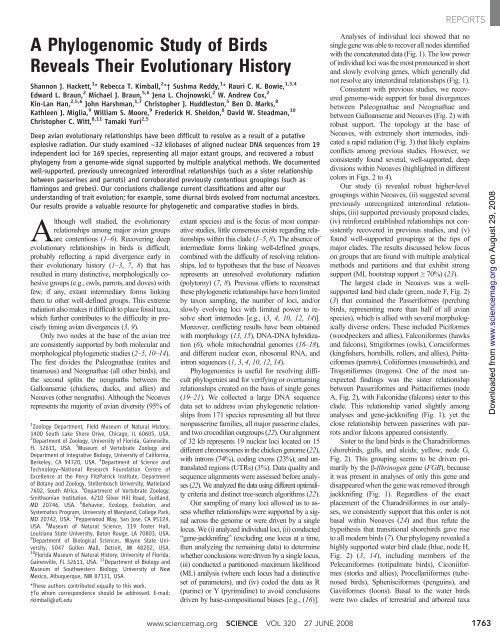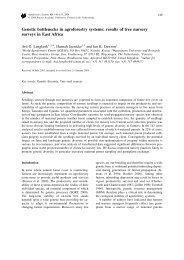A Phylogenomic Study of Birds Reveals Their Evolutionary History
A Phylogenomic Study of Birds Reveals Their Evolutionary History
A Phylogenomic Study of Birds Reveals Their Evolutionary History
You also want an ePaper? Increase the reach of your titles
YUMPU automatically turns print PDFs into web optimized ePapers that Google loves.
A <strong>Phylogenomic</strong> <strong>Study</strong> <strong>of</strong> <strong>Birds</strong><strong>Reveals</strong> <strong>Their</strong> <strong>Evolutionary</strong> <strong>History</strong>Shannon J. Hackett, 1 * Rebecca T. Kimball, 2 *† Sushma Reddy, 1 * Rauri C. K. Bowie, 1,3,4Edward L. Braun, 2 Michael J. Braun, 5,6 Jena L. Chojnowski, 2 W. Andrew Cox, 2Kin-Lan Han, 2,5,6 John Harshman, 1,7 Christopher J. Huddleston, 5 Ben D. Marks, 8Kathleen J. Miglia, 9 William S. Moore, 9 Frederick H. Sheldon, 8 David W. Steadman, 10Christopher C. Witt, 8,11 Tamaki Yuri 2,5Deep avian evolutionary relationships have been difficult to resolve as a result <strong>of</strong> a putativeexplosive radiation. Our study examined ~32 kilobases <strong>of</strong> aligned nuclear DNA sequences from 19independent loci for 169 species, representing all major extant groups, and recovered a robustphylogeny from a genome-wide signal supported by multiple analytical methods. We documentedwell-supported, previously unrecognized interordinal relationships (such as a sister relationshipbetween passerines and parrots) and corroborated previously contentious groupings (such asflamingos and grebes). Our conclusions challenge current classifications and alter ourunderstanding <strong>of</strong> trait evolution; for example, some diurnal birds evolved from nocturnal ancestors.Our results provide a valuable resource for phylogenetic and comparative studies in birds.Although well studied, the evolutionaryrelationships among major avian groupsare contentious (1–6). Recovering deepevolutionary relationships in birds is difficult,probably reflecting a rapid divergence early intheir evolutionary history (1–3, 7, 8) thathasresulted in many distinctive, morphologically cohesivegroups (e.g., owls, parrots, and doves) withfew, if any, extant intermediary forms linkingthem to other well-defined groups. This extremeradiation also makes it difficult to place fossil taxa,which further contributes to the difficulty in preciselytiming avian divergences (3, 9).Only two nodes at the base <strong>of</strong> the avian treeare consistently supported by both molecular andmorphological phylogenetic studies (2–5, 10–14).The first divides the Paleognathae (ratites andtinamous) and Neognathae (all other birds), andthe second splits the neognaths between theGalloanserae (chickens, ducks, and allies) andNeoaves (other neognaths). Although the Neoavesrepresents the majority <strong>of</strong> avian diversity (95% <strong>of</strong>1 Zoology Department, Field Museum <strong>of</strong> Natural <strong>History</strong>,1400 South Lake Shore Drive, Chicago, IL 60605, USA.2 Department <strong>of</strong> Zoology, University <strong>of</strong> Florida, Gainesville,FL 32611, USA.3 Museum <strong>of</strong> Vertebrate Zoology andDepartment <strong>of</strong> Integrative Biology, University <strong>of</strong> California,Berkeley, CA 94720, USA. 4 Department <strong>of</strong> Science andTechnology–National Research Foundation Centre <strong>of</strong>Excellence at the Percy FitzPatrick Institute, Department<strong>of</strong> Botany and Zoology, Stellenbosch University, Matieland7602, South Africa. 5 Department <strong>of</strong> Vertebrate Zoology,Smithsonian Institution, 4210 Silver Hill Road, Suitland,MD 20746, USA.6 Behavior, Ecology, Evolution, andSystematics Program, University <strong>of</strong> Maryland, College Park,MD 20742, USA. 7 Pepperwood Way, San Jose, CA 95124,USA.8 Museum <strong>of</strong> Natural Science, 119 Foster Hall,Louisiana State University, Baton Rouge, LA 70803, USA.9 Department <strong>of</strong> Biological Sciences, Wayne State University,5047 Gullen Mall, Detroit, MI 48202, USA.10 Florida Museum <strong>of</strong> Natural <strong>History</strong>, University <strong>of</strong> Florida,Gainesville, FL 32611, USA. 11 Department <strong>of</strong> Biology andMuseum <strong>of</strong> Southwestern Biology, University <strong>of</strong> NewMexico, Albuquerque, NM 87131, USA.*These authors contributed equally to this work.†To whom correspondence should be addressed. E-mail:rkimball@ufl.eduextant species) and is the focus <strong>of</strong> most comparativestudies, little consensus exists regarding relationshipswithin this clade (1–5, 8). The absence <strong>of</strong>intermediate forms linking well-defined groups,combined with the difficulty <strong>of</strong> resolving relationships,led to hypotheses that the base <strong>of</strong> Neoavesrepresents an unresolved evolutionary radiation(polytomy) (7, 8). Previous efforts to reconstructthese phylogenetic relationships have been limitedby taxon sampling, the number <strong>of</strong> loci, and/orslowly evolving loci with limited power to resolveshort internodes [e.g., (3, 4, 10, 12, 14)].Moreover, conflicting results have been obtainedwith morphology (13, 15), DNA-DNA hybridization(6), whole mitochondrial genomes (16–18),and different nuclear exon, ribosomal RNA, andintron sequences (1, 3, 4, 10, 12, 14).<strong>Phylogenomic</strong>s is useful for resolving difficultphylogenies and for verifying or overturningrelationships created on the basis <strong>of</strong> single genes(19–21). We collected a large DNA sequencedata set to address avian phylogenetic relationshipsfrom 171 species representing all but threenonpasserine families, all major passerine clades,and two crocodilian outgroups (22). Our alignment<strong>of</strong> 32 kb represents 19 nuclear loci located on 15different chromosomes in the chicken genome (22),with introns (74%), coding exons (23%), and untranslatedregions (UTRs) (3%). Data quality andsequence alignments were assessed before analyses(22). We analyzed the data using different optimalitycriteria and distinct tree-search algorithms (22).Our sampling <strong>of</strong> many loci allowed us to assesswhether relationships were supported by a signalacross the genome or were driven by a singlelocus. We (i) analyzed individual loci, (ii) conducted“gene-jackknifing” (excluding one locus at a time,then analyzing the remaining data) to determinewhether conclusions were driven by a single locus,(iii) conducted a partitioned–maximum likelihood(ML) analysis (where each locus had a distinctiveset <strong>of</strong> parameters), and (iv) coded the data as R(purine) or Y (pyrimidine) to avoid conclusionsdriven by base-compositional biases [e.g., (16)].REPORTSAnalyses <strong>of</strong> individual loci showed that nosingle gene was able to recover all nodes identifiedwith the concatenated data (Fig. 1). The low power<strong>of</strong> individual loci was the most pronounced in shortand slowly evolving genes, which generally didnot resolve any interordinal relationships (Fig. 1).Consistent with previous studies, we recoveredgenome-wide support for basal divergencesbetween Paleognathae and Neognathae andbetween Galloanserae and Neoaves (Fig. 2) withrobust support. The topology at the base <strong>of</strong>Neoaves, with extremely short internodes, indicateda rapid radiation (Fig. 3) that likely explainsconflicts among previous studies. However, weconsistently found several, well-supported, deepdivisions within Neoaves (highlighted in differentcolors in Figs. 2 to 4).Our study (i) revealed robust higher-levelgroupings within Neoaves, (ii) suggested severalpreviously unrecognized interordinal relationships,(iii) supported previously proposed clades,(iv) reinforced established relationships not consistentlyrecovered in previous studies, and (v)found well-supported groupings at the tips <strong>of</strong>major clades. The results discussed below focuson groups that are found with multiple analyticalmethods and partitions and that exhibit strongsupport (ML bootstrap support ≥ 70%) (23).The largest clade in Neoaves was a wellsupportedland bird clade (green, node F, Fig. 2)(3) that contained the Passeriformes (perchingbirds, representing more than half <strong>of</strong> all avianspecies), which is allied with several morphologicallydiverse orders. These included Piciformes(woodpeckers and allies), Falconiformes (hawksand falcons), Strigiformes (owls), Coraciiformes(kingfishers, hornbills, rollers, and allies), Psittaciformes(parrots), Coliiformes (mousebirds), andTrogoniformes (trogons). One <strong>of</strong> the most unexpectedfindings was the sister relationshipbetween Passeriformes and Psittaciformes (nodeA, Fig. 2), with Falconidae (falcons) sister to thisclade. This relationship varied slightly amonganalyses and gene-jackknifing (Fig. 1), yet theclose relationship between passerines with parrotsand/or falcons appeared consistently.Sister to the land birds is the Charadriiformes(shorebirds, gulls, and alcids; yellow, node G,Fig. 2). This grouping seems to be driven primarilyby the b-fibrinogen gene (FGB), becauseit was present in analyses <strong>of</strong> only this gene anddisappeared when the gene was removed throughjackknifing (Fig. 1). Regardless <strong>of</strong> the exactplacement <strong>of</strong> the Charadriiformes in our analyses,we consistently support that this order is notbasal within Neoaves (24) and thus refute thehypothesis that transitional shorebirds gave riseto all modern birds (7). Our phylogeny revealed ahighly supported water bird clade (blue, node H,Fig. 2) (3, 14), including members <strong>of</strong> thePelecaniformes (totipalmate birds), Ciconiiformes(storks and allies), Procellariiformes (tubenosedbirds), Sphenisciformes (penguins), andGaviiformes (loons). Basal to the water birdswere two clades <strong>of</strong> terrestrial and arboreal taxaDownloaded from www.sciencemag.org on August 29, 2008www.sciencemag.org SCIENCE VOL 320 27 JUNE 2008 1763



